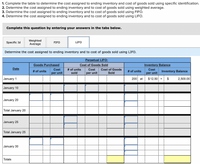
FINANCIAL ACCOUNTING
10th Edition
ISBN: 9781259964947
Author: Libby
Publisher: MCG
expand_more
expand_more
format_list_bulleted
infoPractice Pack
Question
infoPractice Pack
Really not undertsanding LIFO, thank you ahead of time
![Required information
Use the following information for the Exercises 3-7 below. (Algo)
[The following information applies to the questions displayed below.]
Laker Company reported the following January purchases and sales data for its only product. The Company uses a
perpetual inventory system. For specific identification, ending inventory consists of 300 units from the January 30
purchase, 5 units from the January 20 purchase, and 25 units from beginning inventory.
Activities
Units Acquired at Cost
200 units @ $ 12.50 =
Date
Units sold at Retail
$ 2,500
January 1
January 10
January 20
January 25
January 30
Beginning inventory
Sales
Purchase
Sales
Purchase
160 units
$ 21.50
130 units @ $ 11.50 =
1,495
140 units
@
$ 21.50
300 units @ $ 11.00 =
3,300
$ 7,295
Totals
630 units
300 units](https://content.bartleby.com/qna-images/question/cbaaf3a5-97a4-44d4-82b4-c685cbb2fa1a/efbc0a10-60de-4ee9-b4a1-9eb25a01644a/kibzf0d_thumbnail.png)
Transcribed Image Text:Required information
Use the following information for the Exercises 3-7 below. (Algo)
[The following information applies to the questions displayed below.]
Laker Company reported the following January purchases and sales data for its only product. The Company uses a
perpetual inventory system. For specific identification, ending inventory consists of 300 units from the January 30
purchase, 5 units from the January 20 purchase, and 25 units from beginning inventory.
Activities
Units Acquired at Cost
200 units @ $ 12.50 =
Date
Units sold at Retail
$ 2,500
January 1
January 10
January 20
January 25
January 30
Beginning inventory
Sales
Purchase
Sales
Purchase
160 units
$ 21.50
130 units @ $ 11.50 =
1,495
140 units
@
$ 21.50
300 units @ $ 11.00 =
3,300
$ 7,295
Totals
630 units
300 units

Transcribed Image Text:1. Complete the table to determine the cost assigned to ending inventory and cost of goods sold using specific identification.
2. Determine the cost assigned to ending inventory and to cost of goods sold using weighted average.
3. Determine the cost assigned to ending inventory and to cost of goods sold using FIFO.
4. Determine the cost assigned to ending inventory and to cost of goods sold using LIFO.
Complete this question by entering your answers in the tabs below.
Weighted
Average
Specific Id
FIFO
LIFO
Determine the cost assigned to ending inventory and to cost of goods sold using LIFO.
Perpetual LIFO:
Goods Purchased
Cost of Goods Sold
Inventory Balance
Date
# of units
sold
Cost
Cost
Cost of Goods
Sold
Cost
# of units
# of units
Inventory Balance
per unit
per unit
per unit
January 1
200 at
$ 12.50 =
$
2,500.00
January 10
January 20
Total January 20
January 25
Total January 25
January 30
Totals
Expert Solution
This question has been solved!
Explore an expertly crafted, step-by-step solution for a thorough understanding of key concepts.
This is a popular solution
Includes step-by-step video
Trending nowThis is a popular solution!
Learn your wayIncludes step-by-step video
Step by stepSolved in 2 steps

Knowledge Booster
Learn more about
Need a deep-dive on the concept behind this application? Look no further. Learn more about this topic, accounting and related others by exploring similar questions and additional content below.Similar questions
- Will adjusted R2 be a good alternative for evaluating model performance?arrow_forwardPlease answer ASAP if you can please. Thank you! Please Please write expression or formula used Set up expression initially with functional notation (e.g.,(P/F,I,n))arrow_forwardOne characteristic of a well-designed service system is that it is cost-free O True Falsearrow_forward
- Please answer ASAP if you can please. Thank you! Please Please write expression or formula used Set up expression initially with functional notation (e.g.,(P/F,I,n))arrow_forwardMake sure to calculate the NPV correctly! The previous answer was wrong!arrow_forwardhelp please answer in text form with proper workings and explanation for each and every part and steps with concept and introduction no AI no copy paste remember answer must be in proper format with all workingarrow_forward
arrow_back_ios
arrow_forward_ios
Recommended textbooks for you

 AccountingAccountingISBN:9781337272094Author:WARREN, Carl S., Reeve, James M., Duchac, Jonathan E.Publisher:Cengage Learning,
AccountingAccountingISBN:9781337272094Author:WARREN, Carl S., Reeve, James M., Duchac, Jonathan E.Publisher:Cengage Learning, Accounting Information SystemsAccountingISBN:9781337619202Author:Hall, James A.Publisher:Cengage Learning,
Accounting Information SystemsAccountingISBN:9781337619202Author:Hall, James A.Publisher:Cengage Learning, Horngren's Cost Accounting: A Managerial Emphasis...AccountingISBN:9780134475585Author:Srikant M. Datar, Madhav V. RajanPublisher:PEARSON
Horngren's Cost Accounting: A Managerial Emphasis...AccountingISBN:9780134475585Author:Srikant M. Datar, Madhav V. RajanPublisher:PEARSON Intermediate AccountingAccountingISBN:9781259722660Author:J. David Spiceland, Mark W. Nelson, Wayne M ThomasPublisher:McGraw-Hill Education
Intermediate AccountingAccountingISBN:9781259722660Author:J. David Spiceland, Mark W. Nelson, Wayne M ThomasPublisher:McGraw-Hill Education Financial and Managerial AccountingAccountingISBN:9781259726705Author:John J Wild, Ken W. Shaw, Barbara Chiappetta Fundamental Accounting PrinciplesPublisher:McGraw-Hill Education
Financial and Managerial AccountingAccountingISBN:9781259726705Author:John J Wild, Ken W. Shaw, Barbara Chiappetta Fundamental Accounting PrinciplesPublisher:McGraw-Hill Education


Accounting
Accounting
ISBN:9781337272094
Author:WARREN, Carl S., Reeve, James M., Duchac, Jonathan E.
Publisher:Cengage Learning,

Accounting Information Systems
Accounting
ISBN:9781337619202
Author:Hall, James A.
Publisher:Cengage Learning,

Horngren's Cost Accounting: A Managerial Emphasis...
Accounting
ISBN:9780134475585
Author:Srikant M. Datar, Madhav V. Rajan
Publisher:PEARSON

Intermediate Accounting
Accounting
ISBN:9781259722660
Author:J. David Spiceland, Mark W. Nelson, Wayne M Thomas
Publisher:McGraw-Hill Education

Financial and Managerial Accounting
Accounting
ISBN:9781259726705
Author:John J Wild, Ken W. Shaw, Barbara Chiappetta Fundamental Accounting Principles
Publisher:McGraw-Hill Education